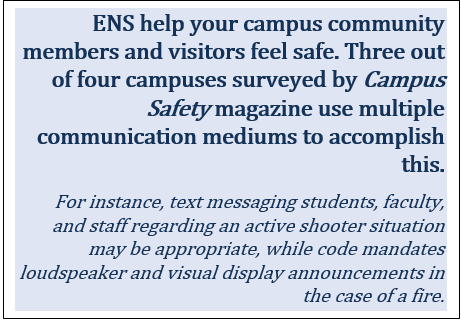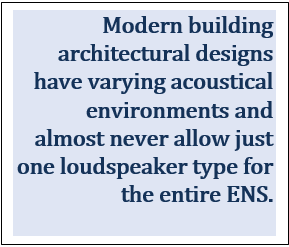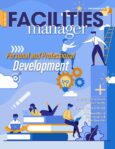Considerations, code compliance requirements, and design parameters for institutions seeking state-of-the-art emergency notification systems (ENS)
— by Tim Waters and Richard Derbyshire
Preparing for unexpected events is not new for higher education institutions. Contemporary emergencies range all the way from campus interlopers bearing weapons to the COVID-19 pandemic. When faced with these situations, campus leaders need to communicate with students, faculty, staff, and visitors in a manner that is effective, immediate, and appropriate for the situation. What means of communication are optimal for each of the myriad of possible circumstances they could face, and which solutions will promote a safe environment?
The Clery Act establishes requirements for these systems; an overview is found in The Handbook for Campus Safety and Security Reporting: 2016 Edition. Application of these requirements is standardized in the National Fire Protection Association (NFPA) Code 72 (latest edition, 2019), as adopted by each local authority having jurisdiction (AHJ). Every campus building is subject to fire codes and regulations for a host of stipulations regarding design, materials, alarm, and announcement systems. Included in NFPA 72 (2019) are design requirements for emergency notification that supplement the fire alarm system to support emergencies other than a fire.
ENS: Not Just an Alarm
Voice audible notifications associated with the fire alarm system are typically considered the most fundamental part of an ENS—conveying situation-specific information to a building or area. Visual displays distributed throughout a building or area can provide similar information. The notification can originate from prerecorded messages or live announcements from a secure station involving a microphone, telephony connection, computer, or other voice-capture or trigger device. (For purposes of this article, ENS includes indoor and outdoor audible and visual display alerts, enterprise messaging including emails, cellular text messaging, and feeds to broadcast radio and television.)
Voice announcements must be intelligible and audible equally throughout the facility.
NFPA 72 (2019) recognizes the importance of acoustics in analyzing a facility, and states that spaces with dissimilar acoustical characteristics should be treated appropriately to achieve the same level of speech intelligibility. The different areas or acoustically distinguishable spaces (ADS) are defined during the design phase and determined by the AHJ; each space should be designed to meet intelligibility and audible requirements as directed by the AHJ. Modern building architectural designs have varying acoustical environments and almost never allow just one loudspeaker type for the entire ENS. Outdoor public address systems—also sometimes referred to as “giant” or “clear” voice systems—for emergency notification involve various other loudspeaker types distinct from those used inside.

Tragically, campuses need to proactively prepare for unfortunate events and integrate active shooter announcements with their ENS. NFPA 3000, Standard for Active Shooter/Hostile Event Response Program, is a critical reference for mitigating or eliminating risks and impact on campus communities.
Assemble Your Team
Leaders of institutions should not attempt to engineer ENS solutions in a vacuum. They should engage stakeholders from facilities management, security, campus police, and the fire marshal, along with information technology and media services as a design team. Outside service providers may add specialized knowledge and experience to the team.
Leaders should discuss, identify, and confirm budget, existing conditions, past practices, and knowledge of the diverse solutions and systems. They should define the various crisis situations and the appropriate processes and procedures for each. When researching the diverse set of available options, it is necessary to align solutions and systems specifically with each situation and associated process and crisis procedure.

Higher education leaders are encouraged to review and participate in Campus Safety: 2020 Emergency Notification Report, an annual survey of ENS systems and their application in diverse emergency situations. According to the Campus Safety reports, many organizations and institutions have yet to complete their adoption or deployment of successful strategies for ENS. The current pandemic introduces yet a new layer of complication as monitoring of people and spaces becomes more prominent. Over time, the evolution of technology and the increasing sophistication of solutions will address the ever-changing safety requirements of campus community members. Nevertheless, choices will become more difficult because there are more of them, requiring properly planned, designed, and deployed systems for maximum benefit.
Tim Waters and Richard Derbyshire are both principals for NV5 Engineering & Technology. They are based in Los Angeles CA and Washington DC, respectively.
This piece originally appeared in the
November/December issue of APPA’s
Facilities Manager magazine


